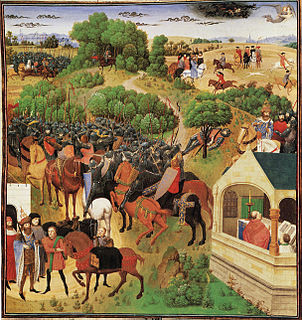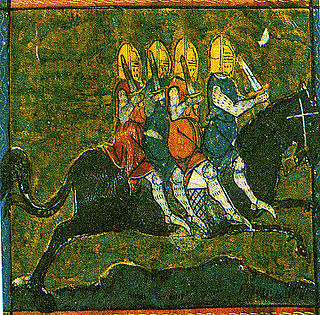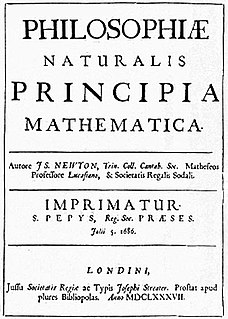Related Research Articles

Thomas Becket, also known as Saint Thomas of Canterbury, Thomas of London and later Thomas à Becket, was Archbishop of Canterbury from 1162 until his murder in 1170. He is venerated as a saint and martyr by the Catholic Church and the Anglican Communion. He engaged in conflict with Henry II, King of England, over the rights and privileges of the Church and was murdered by followers of the king in Canterbury Cathedral. Soon after his death, he was canonised by Pope Alexander III.
Poetry took numerous forms in medieval Europe, for example, lyric and epic poetry. The troubadours and the minnesänger are known for their lyric poetry about courtly love.

Medieval literature is a broad subject, encompassing essentially all written works available in Europe and beyond during the Middle Ages. The literature of this time was composed of religious writings as well as secular works. Just as in modern literature, it is a complex and rich field of study, from the utterly sacred to the exuberantly profane, touching all points in-between. Works of literature are often grouped by place of origin, language, and genre.

The chanson de geste is a medieval narrative, a type of epic poem that appears at the dawn of French literature. The earliest known poems of this genre date from the late 11th and early 12th centuries, shortly before the emergence of the lyric poetry of the troubadours and trouvères, and the earliest verse romances. They reached their highest point of acceptance in the period 1150–1250.

Bayard is a magic bay horse in the legends derived from the chansons de geste. He is renowned for his spirit, and possesses the supernatural ability to adjust his size to his riders.
According to the medieval poet Jean Bodel, the Matter of Rome is the literary cycle of Greek and Roman mythology, together with episodes from the history of classical antiquity, focusing on military heroes like Alexander the Great and Julius Caesar. Bodel’s division of literary cycles also included the Matter of France and the Matter of Britain. The Matter of Rome includes the Matter of Troy, consisting of romances and other texts based on the Trojan War and its legacy, including the adventures of Aeneas.
The Matter of France, also known as the Carolingian cycle, is a body of literature and legendary material associated with the history of France, in particular involving Charlemagne and his associates. The cycle springs from the Old French chansons de geste, and was later adapted into a variety of art forms, including Renaissance epics and operas. Together with the Matter of Britain, which concerned King Arthur, and the Matter of Rome, comprising material derived from and inspired by classical mythology, it was one of the great European literary cycles that figured repeatedly in medieval literature.
Anglo-Norman literature is the literature composed in the Anglo-Norman language and developed during the period of 1066 - 1204, as the Duchy of Normandy and the Kingdom of England were united in the Anglo-Norman realm.

William of Gellone, the medieval William of Orange, was the second Duke of Toulouse from 790 until 811. In 804, he founded the abbey of Gellone. He was canonized a saint in 1066 by Pope Alexander II.

Medieval French literature is, for the purpose of this article, Medieval literature written in Oïl languages during the period from the eleventh century to the end of the fifteenth century.

The Young Girls of Rochefort is a 1967 French musical comedy film written and directed by Jacques Demy. The ensemble cast is headlined by real-life sisters Catherine Deneuve and Françoise Dorléac, and features George Chakiris, Michel Piccoli, Jacques Perrin, Grover Dale and Geneviève Thénier, along with Gene Kelly and Danielle Darrieux.

Edward Grim was a monk from Cambridge who visited Canterbury Cathedral on Tuesday 29 December 1170 when Thomas Becket was murdered. He researched and published a book, Vita S. Thomae in about 1180, which is today known chiefly for a short section in which he gave an eyewitness account of the events in the cathedral.

The Cançóde Santa Fe, a hagiographical poem about Saint Faith, is an early surviving written work in Old Occitan and has been proposed to be the earliest work in Old Catalan. It is 593 octosyllabic lines long, divided into between 45 and 55 monorhyming laisses. It was written between 1054 and 1076, during the reign of Ramon Berenguer I, Count of Barcelona, by an anonymous poet.
Gormond et Isembart is an Old French chanson de geste from the second half of the eleventh or first half of the twelfth century. Along with The Song of Roland and the Chanson de Guillaume, it is one of the three chansons de geste whose composition incontestably dates from before 1150; it may be slightly younger than The Song of Roland and, according to one expert, may date from as early as 1068. The poem tells the story of a rebellious young French lord, Isembart, who allies himself with a Saracen king, Gormond, renounces his Christianity, and battles the French king. The poem is sometimes grouped with the Geste de Doon de Mayence or "rebellious vassal cycle" of chansons de geste.

The literature of England is literature written in what is now England, or by English writers. It consists mainly of English literature - i.e. literature written in the English language - but there are important examples of literature from England written in other languages.
Reginald of Canterbury was a medieval French writer and Benedictine monk who lived and wrote in England in the very early part of the 12th century. He was the author of a number of Latin poems, including an epic entitled Malchus, which still survives.
William of Canterbury (floruit 1170–1177) was a medieval English monk and biographer of Thomas Becket, the Archbishop of Canterbury murdered in December 1170. He was present at the murder of the archbishop and admitted in his writings that he ran from the murder scene. Later he collected miracle stories about Becket. He also wrote a hagiography, or saint's life, of Becket, one of five written at Canterbury soon after Becket's death. William's hagiography was later used by other medieval writers who wrote about Becket.
Clemence of Barking was a 12th-century Benedictine nun and Anglo-Norman poet-translator of Barking Abbey. She is noted for writing a translation of the biography, the Life of Saint Catherine. Clemence's hagiography of Saint Catherine of Alexandria is widely regarded as, what would be considered today, a feminist text.
Aiol and Mirabel is an Old French chanson de geste. Originating probably in the late twelfth century, the oldest copy in Old French dates from circa 1280. It was translated into Middle Dutch, Italian, and Spanish. The narrative recounts the adventures of the young knight Aiol who attempts to restore his father's fiefdom, and along the way marries a Saracen princess.
Saint Thomas Becket window in Chartres Cathedral is a 1215–1225 stained-glass window in Chartres Cathedral, located behind a grille in the Confessors' Chapel, second chapel of the south ambulatory. 8.9 m high by 2.18 m wide, it was funded by the tanners' guild. The furthest left of five lancet windows in the chapel, it is difficult to view and is heavily corroded by glass oxidisation, which has made its left side especially hard to read.
References
- ↑ Knowles, David, The Episcopal Colleagues of Archbishop Thomas Becket, Cambridge University Press, Cambridge: 1951, p. 54
- ↑ Shirley, p. xi
- 1 2 3 4 5 6 Staunton, Michael (2006) Thomas Becket and his Biographers, The Boydell Press, Woodbridge, pp. 32–33, ISBN 1843832712.
- 1 2 Short, Ian (1977). "An Early Draft of Guernes' Vie de saint Thomas Beckett". Medium Aevum. 46: 20–34 (21).
- 1 2 3 4 Phyllis, Johnson and Cazelles, Brigitte (1979) "Le vain siecle Guerpir: A Literary Approach to Sainthood Through Old French Hagiography of the Twelfth Century," in North Carolina Studies in the Romance Languages and Literatures, no. 205, Spain, pp. 296–297
- ↑ Shirley, p. xv
- 1 2 3 4 5 Shirley, p. xiii
- ↑ Shirley, p. xii
- 1 2 Ford, J.D.M. (1934). "The Saints' Lives in the Vernacular Literature of the Middle Ages". Catholic Historical Review. 17 (3): 268–277 (269–270). JSTOR 25012913.
- 1 2 3 Dembowski Peter F. (1976). "Literary Problems of Hagiography in Old French". Medievalia et Humanistica. 7: 119–120.
- ↑ O'Reilly, Jennifer L., "The Double Martyrdom of Thomas Becket: Hagiography or History?" in Studies in Medieval and Renaissance History, (vol. 17, New York: AMS Press, 1985) p. 185
- ↑ O'Reilly, Jennifer L., "The Double Martyrdom of Thomas Becket: Hagiography or History?" in Studies in Medieval and Renaissance History, (vol. 17, New York: AMS Press, 1985) p. 188